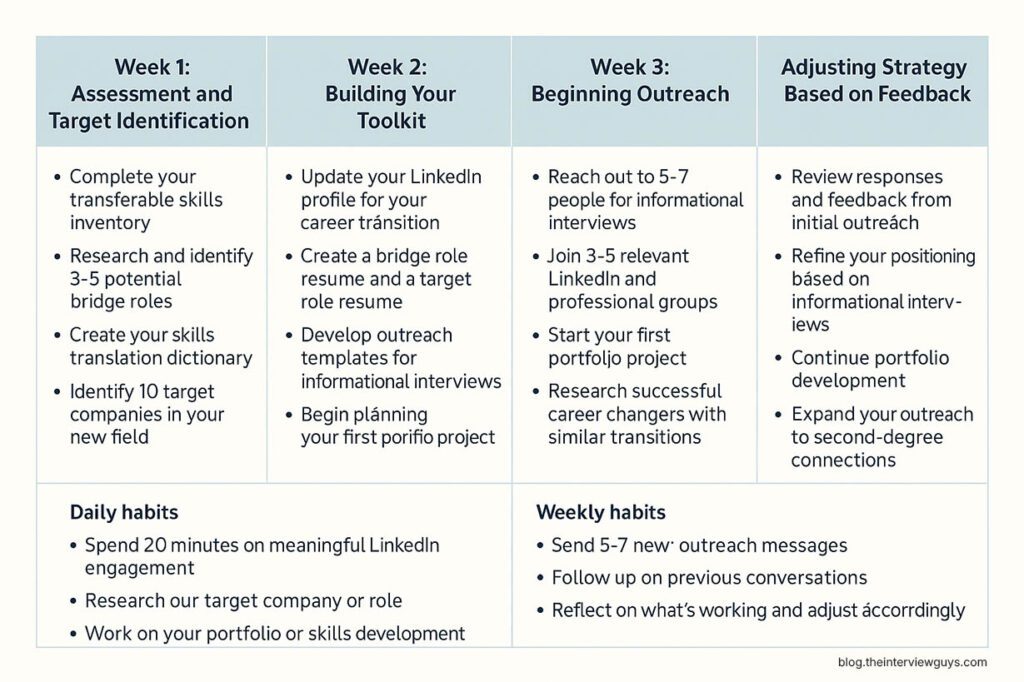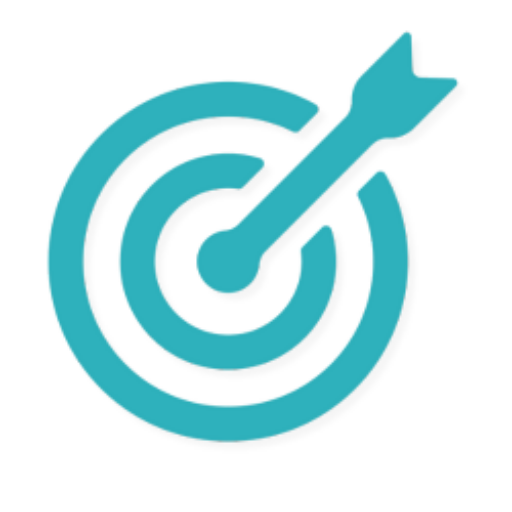Hidden Job Market for Career Changers: How to Break Into a New Field Without Starting Over
The average person will change careers 5-7 times during their working life—a statistic that’s both liberating and terrifying.
While the freedom to reinvent yourself professionally is greater than ever, the traditional job search methods simply weren’t designed for career changers.
You’re immediately caught in what we call the experience paradox: you can’t get experience without a job in the new field, but you can’t get hired without that same experience. It’s enough to make anyone feel like they’re starting from scratch.
But here’s what most career changers don’t realize: you don’t need to start over if you know how to tap into the hidden job market.
In our previous article on The Hidden Job Market, we explained how up to 80% of positions are filled without ever being publicly advertised.
For career changers, this hidden market isn’t just a useful supplement to your job search—it’s absolutely essential.
Why? Because the hidden job market bypasses many of the traditional gatekeepers (like ATS systems and HR screeners) that automatically filter out “non-traditional” candidates.
It gives you direct access to decision-makers who can appreciate the unique value you bring from your previous field.
Let’s dive into exactly how career changers can leverage the hidden job market to break into a new field without starting over.
☑️ Key Takeaways
- The hidden job market includes roles that are never publicly posted, often filled through referrals or internal networks.
- Career changers benefit from this market because it’s less focused on perfect resumes and more on personal connection.
- Informational interviews and networking are key to uncovering these unlisted opportunities.
- Position yourself as a problem-solver with transferable skills, so decision-makers see you as a strong fit—even without direct experience.
Why Career Changers Need the Hidden Job Market
When you submit your resume through a job board or company website as a career changer, you’re immediately at a disadvantage.
Applicant Tracking Systems (ATS) are programmed to look for candidates with direct experience in the field—something you technically don’t have.
Even if a human reviews your application, studies show they spend an average of just 7.4 seconds scanning a resume. Without obvious industry keywords and titles, your application likely won’t make it past this initial review.
But the hidden job market operates differently. According to a Harvard Business Review study on career transitions, successful career changers are 2.5 times more likely to have found their new roles through personal connections than through job postings.
The psychology behind this is simple: hiring managers take greater risks on non-traditional candidates when those candidates come with a personal recommendation.
This is why career changers actually have unique advantages in the hidden job market:
- You bring fresh perspectives that can help solve industry problems in new ways
- You have skills from your previous field that might be rare in your target industry
- You’re often more motivated and committed than candidates who’ve always been in the field
- You’re less likely to be comparing multiple offers, making you a more reliable hire
The key is learning how to position these advantages effectively—and that starts with understanding your transferable skills.
Skill Translation: Your Secret Weapon
The biggest mistake career changers make is believing they’re “starting from scratch.”
You’re not starting over—you’re transferring and translating your existing skills into a new context.
Creating your transferable skills inventory is the foundation of your entire career change strategy. Here’s how to do it:
- List all your professional skills, both technical and soft skills
- Research your target industry through job descriptions, industry articles, and LinkedIn profiles
- Identify overlapping skills that appear in both your inventory and the industry research
- Translate your existing skills into the language of your target industry
The three categories of transferable skills to focus on are:
Technical/hard skills: These might include data analysis, writing, research, design principles, or technical tools that apply across industries.
Soft skills/people skills: Skills like client management, team leadership, conflict resolution, or presentation abilities are valuable in almost every field.
Industry-agnostic processes: Project management, budget development, strategic planning, and quality assurance processes often work similarly across different sectors.
Jennifer, a high school English teacher for eight years, successfully transitioned to project management by reframing her experience:
- Lesson planning became project planning
- Classroom management became stakeholder management
- Curriculum development became process improvement
She never “started over”—she simply translated her existing skills.
Interview Guys Tip: Create a “skills translation dictionary” for yourself that maps terms from your current industry to equivalent terms in your target industry. For example, “patient care” might translate to “client experience” or “customer success” in a business context.
Hidden Job Market Strategy #1: The Strategic Informational Interview
For career changers, informational interviews are your golden ticket into the hidden job market.
Unlike regular networking, informational interviews allow you to gain industry insights while demonstrating your transferable skills—all without the pressure of a formal job interview.
But most people approach informational interviews all wrong. They focus on what they want rather than what they can offer, which rarely leads to meaningful connections.
As we detailed in our guide to How to Turn Cold Connections into Job Referrals, the most successful approach follows our Tailoring Method—focusing on what you can offer rather than what you need.
For career changers specifically, here’s an outreach template that works:
“Hi [Name], I noticed your work on [specific project/article]. I’m transitioning from [your field] to [target field] and was impressed by how you [specific accomplishment]. My background in [relevant aspect of your experience] gave me a unique perspective on [industry challenge they might face]. I’d love to learn more about your journey and potentially share some insights from my experience in [your field] that might be valuable. Would you be open to a 20-minute conversation?”
During the informational interview, be sure to ask these five questions:
- “What challenges is your industry currently facing that someone with my background might help solve?”
- “What skills from other industries have you seen people successfully bring into this field?”
- “If you were in my position, what would be your strategy for breaking into this industry?”
- “What bridge roles might be appropriate given my background?”
- “Who else would you recommend I speak with to learn more?”
Marcus, an accountant for 12 years, used this exact approach to transition into UX design.
His conversation with a design director revealed that financial software companies desperately needed designers who understood accounting workflows.
This insight led to three introductions and eventually a role that valued both his accounting knowledge and his self-taught design skills.
Hidden Job Market Strategy #2: The Bridge Role Approach
One of the most successful pathways into a new field is through what we call “bridge roles”—positions that combine elements of your current expertise with aspects of your target field.
Bridge roles allow you to leverage your existing experience while building credibility in your new field.
They’re the career change equivalent of keeping one foot on solid ground while stepping into new territory.
To identify potential bridge roles:
- Look for hybrid job titles (e.g., “Marketing Analytics Specialist” bridges marketing and data analysis)
- Search for roles in your current industry that use skills from your target field
- Consider positions in your target field that value expertise from your current industry
- Look for startup and growth-stage companies that often have less rigid job descriptions
Analyzing job descriptions is crucial for finding these bridge opportunities.
Look for overlap between the requirements and your current skills. If a job description has at least 50% of requirements that match your existing experience, it’s a potential bridge role worth pursuing.
This is where our Tailoring Method becomes essential. Your resume, LinkedIn profile, and networking conversations need to emphasize the aspects of your experience that are most relevant to the bridge role.
Sarah, a marketing manager, successfully transitioned to data analytics by first taking a marketing analytics role.
This bridge position allowed her to leverage her marketing expertise while developing her technical skills.
Within 18 months, she moved into a full data analytics role, bypassing entry-level positions entirely.
Interview Guys Tip: Create two versions of your resume—one targeting direct entry into your new field and another targeting bridge roles. The bridge role resume should emphasize your current industry expertise alongside your developing skills in the new field.
Hidden Job Market Strategy #3: The Project Portfolio Strategy
For career changers, a well-crafted project portfolio often speaks louder than a resume.
It provides tangible evidence of your abilities in your target field, even without formal job experience.
According to a survey of hiring managers, 76% said they would consider a candidate with strong project work but limited professional experience over a candidate with more experience but no portfolio.
The key is building strategic projects that:
- Solve real problems in your target industry
- Demonstrate your transferable skills
- Show your understanding of industry challenges
- Ideally combine knowledge from your previous field with skills from your new field
James, a sales professional transitioning to web development, created a customer relationship management tool specifically designed for sales teams.
His project showcased both his coding skills and his deep understanding of sales processes—making him much more valuable than a junior developer without sales knowledge.
Your portfolio should include 3-5 high-quality projects rather than a large number of basic examples. Focus on quality and relevance over quantity.
The Muse provides excellent guidance on building an effective career change portfolio, emphasizing the importance of storytelling to connect your past experience with your future direction.
When presenting your portfolio:
- Lead with your strongest, most relevant project
- Clearly explain the problem you were solving
- Detail your process and decision-making
- Highlight results or feedback if available
- Explicitly connect the project to transferable skills from your previous career
Hidden Job Market Strategy #4: The Advanced LinkedIn Method
LinkedIn becomes even more powerful for career changers when you know how to use it strategically.
Beyond the basics, there are several advanced techniques specifically valuable for those transitioning fields.
As we detailed in our guide to Secret LinkedIn Search Strings, you can use Boolean search operators to find exactly the right connections for your career change journey.
For career changers specifically, try these powerful search strings:
("former" OR "ex" OR "previously") AND ("your current job title") AND ("your target job title")This finds people who made the exact career transition you’re targeting("hiring" OR "building team" OR "looking for") AND ("your target role") NOT ("years experience")This finds hiring managers who might be open to non-traditional backgroundsreskill OR "career changer" OR "career transition" OR "career pivot" AND ("your target industry")This finds people and resources discussing career changes in your target field
Beyond search, optimize your LinkedIn profile with these career-changer strategies:
- Rewrite your headline to include both your current expertise AND your target field
- In your summary, explicitly address your career change and the value your background brings
- Reorganize your experience section to highlight relevant transferable skills
- Join and actively participate in groups related to your target industry
- Create and share content that bridges your current knowledge with your target field
The most overlooked LinkedIn strategy is engagement.
Thoughtfully commenting on posts from leaders in your target industry can build visibility and relationships without direct outreach.
Aim for 2-3 substantive comments daily on content from potential hiring managers or influential people in your target field.
Interview Guys Tip: Use LinkedIn to reverse-engineer successful career changes similar to yours. Find 5-10 people who made the transition you’re targeting and analyze their path: What bridge roles did they take? What skills do they highlight? What certifications did they acquire? This research can reveal patterns that might not be obvious otherwise.
Hidden Job Market Strategy #5: The AI-Enhanced Approach
AI tools are revolutionizing the job search process, offering particularly valuable advantages for career changers.
As we explored in our article on How AI is Revolutionizing the Job Search Process, these tools can help you identify hidden opportunities and position yourself more effectively.
For career changers specifically, AI can help with:
Skills gap analysis: AI tools can compare your current skills against requirements in your target field, identifying specific gaps to address through projects, courses, or volunteer work.
Job description analysis: AI can process hundreds of job descriptions in your target field to identify patterns, common requirements, and the most valuable transferable skills to emphasize.
Tailored outreach messages: AI can help craft personalized messages that effectively bridge your past experience with your target role, increasing response rates for networking outreach.
Industry-specific resume optimization: AI tools can suggest industry-appropriate terminology and formatting to help your resume pass both ATS screening and human review.
When using AI in your job search, remember that these tools should enhance your human connection, not replace it.
Use AI to handle repetitive tasks and initial analysis, but always add your personal touch to final communications.
Navigating Objections: Preparing for the “But You Don’t Have Experience” Conversation
Even with the perfect hidden job market strategy, you’ll inevitably face the experience question. Preparing for this conversation is crucial for career changers.
The four most common objections you’ll face are:
- “You don’t have industry experience.”
- “You haven’t used our specific tools/technologies.”
- “You don’t understand our unique challenges.”
- “You’d be taking a step backward in your career.”
For each objection, prepare a specific response using the CAR method (Challenge, Action, Result):
- Challenge: Acknowledge the concern without being defensive
- Action: Explain how you’ve prepared for this exact challenge
- Result: Share a specific example that demonstrates your ability to overcome similar challenges
For example, when facing the “industry experience” objection, a former teacher transitioning to project management might say:
“I understand that education and corporate environments have different dynamics. That’s why I’ve completed three project management simulations specifically in corporate settings. In one simulation, I managed a product launch with a cross-functional team—similar to how I coordinated multiple stakeholders for school-wide initiatives. In my last year of teaching, I implemented a new curriculum tracking system that reduced planning time by 30%—demonstrating my ability to drive efficiency improvements in any environment.”
The key is addressing the underlying concern while highlighting relevant transferable skills.
Don’t dismiss the objection—transform it into an opportunity to showcase your unique value.
Dana, a nurse who successfully transitioned to healthcare IT, faced constant questions about her technical credentials.
Instead of becoming defensive, she reframed the conversation:
“My eight years working directly with electronic health records from the clinical side gives me insights that pure IT specialists don’t have. I’ve been the frustrated end-user trying to document patient care while navigating poorly designed systems. That experience, combined with my technical certification, means I can build solutions that actually work for clinical staff.”
Interview Guys Tip: Create an “objection response document” with prepared answers to common concerns. Practice these responses until they feel natural, focusing on the balance between acknowledging concerns while confidently presenting your unique value proposition.
Timeline and Expectations: The Reality of Career Change
Career transitions through the hidden job market typically take 3-8 months, depending on several factors:
- How closely related your target field is to your current one
- The strength of your existing network
- The demand for skills in your target industry
- Your financial runway for the transition
- How effectively you implement the strategies above
To set appropriate expectations, establish these milestones for your transition:
1-2 months: Research phase and beginning informational interviews
2-3 months: Building your portfolio and strategic networking
3-6 months: Applying for bridge roles and direct opportunities
6-8 months: Securing and starting your new position
Throughout this timeline, track these success metrics:
- Number of informational interviews conducted
- Quality connections made in your target field
- Responses to your tailored outreach
- Feedback on your portfolio projects
- Progress in skills development
Red flags that your approach needs adjustment include:
- No responses to 10+ outreach attempts
- Consistent feedback about the same skill gap
- Difficulty articulating your transferable skills
- No second conversations from informational interviews
If you’re hitting these roadblocks, consider:
- Adjusting your target roles to better align with your current skills
- Pursuing additional training or certifications
- Seeking volunteer or project opportunities to build relevant experience
- Refining your positioning and personal narrative
Implementation Plan: Your First 30 Days
Success in accessing the hidden job market requires consistent, strategic action. Here’s exactly what to do in your first month:

Conclusion
Breaking into a new field without starting over isn’t just possible—it’s happening every day for professionals who understand how to leverage the hidden job market effectively.
The key is recognizing that your previous experience isn’t a liability—it’s your greatest asset when properly translated and positioned.
By using these hidden job market strategies, you can bypass traditional gatekeepers and connect directly with decision-makers who value your unique combination of skills and perspectives.
Your career change journey starts today. Choose one strategy from this article and take concrete action in the next 24 hours.
Remember: every expert in your target field was once a beginner, and many successful professionals have navigated the exact transition you’re making now.

BY THE INTERVIEW GUYS (JEFF GILLIS & MIKE SIMPSON)
Mike Simpson: The authoritative voice on job interviews and careers, providing practical advice to job seekers around the world for over 12 years.
Jeff Gillis: The technical expert behind The Interview Guys, developing innovative tools and conducting deep research on hiring trends and the job market as a whole.
